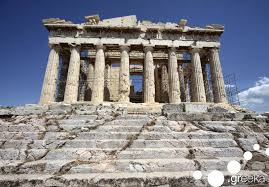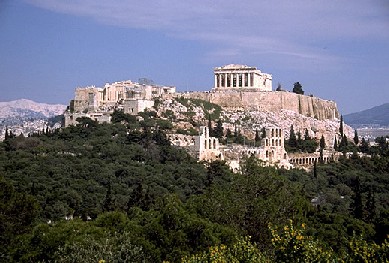The history of Greece can be traced back to Stone Age hunters. Later came early farmers and the civilizations of the Minoan and Mycenaean kings. This was followed by a period of wars and invasions, known as the Dark Ages. In about 1100 BC, a people called the Dorians invaded from the north and spread down the west coast.
The dark ages were followed by a resurgence of civilization in the Archaic age and in this in this period from 500-336 BC Greece was dividTed into small city-states, each of which consisted of a city and its surrounding countryside.

There were only a few historians in the time of Ancient Greece. Three major ancient historians were able to record their time of Ancient Greek history, that include Herodotus, known as the ‘Father of History’ who traveled to many ancient historic sites at the time, Thucydides and Xenophon.
Most other forms of History knowledge and accountability of the ancient Greeks we know is because of temples, sculpture, pottery, artifacts and other archaeological findings.
Important Periods of Greek History:
- Neolithic
- Early Bronze
- Minoan
- Mycenaean
- The Dark Ages
- Archaic
- Classical
- Hellenistic
- BC: 6000-2900 2900-2000 2000-1400 1600-1100 1100-750 750-500 500-336 336-146
Geography:
Athens is the symbol of freedom, art, and democracy in the conscience of the civilized world. The capital of Greece took its name from the goddess Athena, the goddess of wisdom and knowledge. Greece basically is made up of a huge mainland which is at the southern tip of the Balkans, the peninsula of Peloponnesus and also several islands which include Rhodes, Crete, Euboea, Dodecanese, Kos and also the Ionian sea islands. This country has around 15,000 kilometres of coastline and also a huge boundary which is around 1,160 kilometres. The land was mostly mountainous or high lands with only about 20 per cent land being suitable for cultivation.

City states
Polis was the ancient Greek units of sovereignty or states which functioned just like countries. It consisted of an urban complex and then the surrounding agricultural hinterland. Polis is a Greek word that is translated to English as a city-state.
Every polis was typically just one city but each city had its own political, judicial, legal and religious systems. Hence each polis was apparently an independent state. This independent polis would indulge in trade and international affair with other polls as well as other countries mostly via the sea
Elements of Ancient Greek Polis
A city-state or polis consisted of the following elements:
- A main urban city complex, which was the main center of trade and commerce, and the area of prosperity. Most of the wealthy free citizens lived here in the cities and the whole polis was governed from this urban area. It was also the area of art and crafting with the artist living in service of their masters.
- A surrounding rural hinterland that consisted of agricultural lands, mines, quarries, etc. The rural areas supplied most of the food to the population in the cities as well as the resources for trade and business.
- An Acropolis which consisted of all of the government and other important buildings. This was mostly placed on high ground or a large rock outcrop like in Athens which also provided protection to the administrators and the powerful. This is where most of the temples and places of worship were located.
- An Agora, which was the marketplace for the Polis. This was where all the trade and commerce took place. It was the main center of the transaction and the economy.

Olympic Games
The Olympic Games are also a contribution of the Greeks to the world. The ancient Greeks loved competitions of all sorts, especially sporting competitions. The Olympics were not the only competitive games held in ancient Greece, but they were the most popular. Sports like boxing, wrestling, discus, javelin throw, jumping, racing became very popular and have inspired the modern versions of this.
The Olympics held great great prestige in the ancient Greek world being a great sporting event so great that even wars were temporarily stopped for letting athletes participate in the games.
Ancient Greece Culture And Society
Social Structure
Greece in the Archaic Period was made up of independent states, called Polis (In Greek Things), or city-state. The polis of Athens included about 2,500 sq kilometers of territory, but other Polis with smaller areas of 250 sq kilometers.Greek Society was mainly broken up between Free people and Slaves, who were owned by the free people.
Slaves were used as servants and laborers, without any legal rights. Sometimes the slaves were prisoners of war or bought from foreign slave traders. Although many slaves lived closely with their owners, few were skilled craftsmen and even fewer were paid.

Types of Governments in Ancient Greece
There were mainly four main types of governments in ancient Greece:
- Aristocracy was the most commonly found system of government in which there was a completely different political class known as the aristocrats who monopolized political power excluding the masses.
- Tyranny was the rule by the one who overthrew the ruling order and monopolized political power in his own hands mostly with the support of the masses.
- Democracy was a system of direct rule by the masses through voting and debates, and all the policies decided by the popular assemblies.
- Monarchy was uncommon but it was still present in certain states like Sparta which were ruled by royal families or a single royal king.
The government of Greek:
Mycenean Era
The majority of Greek states were governed by groups of rich landowners, called aristocrats; this word is derived from ‘Aristoi’, meaning best people. This was a system known as ‘oligarchy’ the rule by the few. In this time all land was controlled by aristocrats and the administration was controlled from Palatial buildings with this system being known as palace bureaucracies.
Archaic Period
Athenian power in the Archaic Period was controlled by Aeropagus or council. Their policies were delivered through three magistrates called Archons. Most of the states in this time was now installing Tyrants in place of oligarchies and it was known as the Age of Tyrants. Here single powerful tyrants monopolized power and ran states aithoritatively.
Classical Period
People soon became disgruntled by tyrangts and wanted a share in the running of the states. Democracy was thus introduced by an aristocrat, Cleisthenes. Who was from a family of the Alcmaeonids in 508 BC, after 2 years of civil war, they used the help of Spartans to secure power. This gave the right to vote to free citizens to select policies of the state. Most states even if they did not have full democracy, had established popular council where people could raise their opinion.
Rise of Alexander
Alexander succeeded his father, Philip, to the throne of Macedonia and embarked on a journey of war and conquests. He was the first ruler to unify the entire Greek mainland under one ruler. He ruled by force and the fear of his extremely efficient army, destroying anyone that dared to challenge his might. He broke the independence of Greek states to bring them under his monarchical rule.
Military
Bronze armies in Greece were controlled and dominated by armored aristocrats on their chariots while infantry played a supporting role. But with the coming of the Archaic and classical age, a group of wealthy farmers became involved in wars as heavy infantry which came to be known as the hoplites. A hoplite army became the norm for every Greek state in which the hoplites in heavy armor fought side by side in tight formations in directly confronted battles which resulted in direct wins or losses without much room for tactics with the main emphasis being on the ability to hold on.
Economy
The prosperity of Ancient Greece was mainly due to overseas trade. The city-states were very isolated and engulfed themselves more in seafaring bringing the main source of wealth. The luxury items of ancient Greece, wine, and olives were popular items of export from Greece.
Apart from trade, there were also several trades, queries that had rich natural resources which yielded great wealth to their owners. Slaves were the main workers in these mines and states like Athens gained great wealth from their diamond mines.
There were main states who had no access to the sea, especially the Peloponnesians, and could not trade. So these inland states had to depend on agriculture for their economy. But with very little land fir for agriculture, they had to hunt for other lands for their safety in the food supply. For example, Sparta derived most of its wealth from the called region of Messenia.
Society
Ancient Greece was a highly unequal society with the aristocrats reuniting great wealth and prosperity. Apart from them the traders and merchants also grew wealthy from their overseas trade.
But on the other hand, slaves were at the bottom of the social ladder and had to work at the whim of their masters. Ancient Greek society was also known as a slave society with most of their surplus being derived from the labor of their states.
Even their women had no freedom in society and had to stay indoors except for a male to accompany them outside. They did not enjoy any rights and were expected to just take care of the household and children. Their marriage was also primarily the concern of the make members and a heavy dowry had to be paid by the side of the bride in ancient Greece
Art And Architecture:
Other Greek Things, Greek life was dominated by religion and so it is not surprising that the temples of ancient Greece were the biggest and most beautiful. They also had a political purpose as they were often built to celebrate civic power and pride or offer thanksgiving to the patron deity of a city for success in war. In Athens memory never fades. Wherever you stand, wherever you turn, the city’s long and rich history will be alive in front of you. This is where that marvel of architecture, the Parthenon, was created. This is where art became inseparable from life, and this is where Pericles gave the funerary speech, that monument of the spoken word.
The Ancient Greeks were known for their huge architectural structures which made them look majestic while the arts main focus was on perfect potrayals of human ohysique especialy the nude male torso with still many statues remaining showing the idealistic nude male figure. With time they also focusing on the emotional potrayal of their human figures.
More Info on – ancient Greece facts, Greece gods, ks2, kids, food
